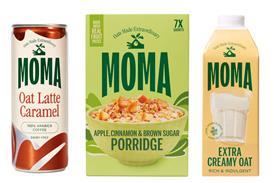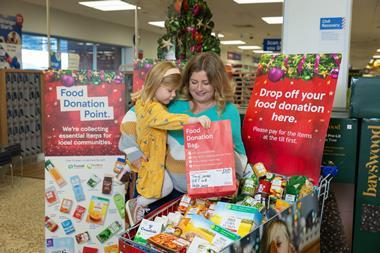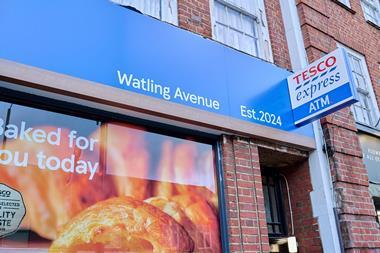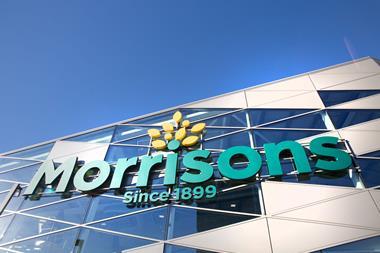Brands beware! Own label is marching on and up, says Liz Hamson
Sharoff believes that the retailers’ switch in focus to own label dates back to Wal-Mart’s entry into the UK market with the Asda acquisition. “It changed the dynamic. It was no longer about brands asserting themselves but about the do-or-die contest between the retailers. Own label is a powerful weapon.”
This week’s news that Asda is considering launching three premium own-label ranges, Chef’s Specials, Italian Choice and Pub Menu, illustrates perfectly just how far supermarket own label has evolved over the past couple of years.
These days it is no longer about ‘me-toos’ in two to three different price brackets, but a whole subset of brands covering everything from gastro pub food to healthy eating, organic food and posh ready meals. And with the consumer appetite for the likes of Tesco Finest showing no signs of abating, it is no surprise that own label is on the ascendant again.
It has leapt from 38% to 41.5% this year - its highest level for four years - according to the latest figures from the Private Label Manufacturers’ Association. Brian Sharoff, PLMA president, says: “For the past three years own label in the UK seemed to be flat or even seeing some erosion in various categories. But this year there seems to have been an upward trend.”
TNS Superpanel data paints a similar picture and shows a particularly striking upturn in premium own label lines. So why the sudden renaissance?
Customer-targeted brands in premium, organic and healthy eating are driving the growth. Sharoff says: “It is the premium ranges that have driven the own label increase. Tesco is such a strong own label advocate and the others are forced to pay attention and emulate. The second factor is the metamorphosis of the consumer. They are more inclined towards ready meals and that’s where the Tescos and Sainsburys excel.”
Ed Garner, communications director, TNS Superpanel, agrees, adding that there were early signs of an upturn as far back as 2002. “If you look at the sales figures, you can see the main growth is coming from Tesco Finest and Sainsbury Taste The Difference.”
Nowhere more is this the case than in the chilled category, which is why the multiples have made such a play for premium, suggests Sharoff. “There is a lot of potential to add value.”
Manufacturers haven’t done themselves any favours by allowing retailers a clear run, he adds. “These are categories dominated by retailer brands. Part of this has to do with the inability of the ‘A’ brands to innovate and be creative. Part has to do with greater competition among the retailers as they battle to create greater awareness of their own labels.”
The battle is not only being fought on the premium front, hence this year’s overall upturn. Value ranges are also growing, partly in a bid to counter any downturn in the economy and partly in response to the hard discounters, he points out.
Sharoff says: “Value brands are always a defensive step that retailers take because they don’t control the economy. But the discounters have created havoc. Tesco may have gone further with value than it might have wanted to go, but it is now contributing to this defensive trend.”
In other words, manufacturers beware: supermarket own labels are the new brands as far as consumers are concerned. And that means that there’s not going to be any imminent u-turn on the part of the multiples.
They confirm as much themselves. Sainsbury, which last week announced it was relaunching and extending its organic range to coincide with its sponsorship of Organic Week next month, says that it is now back up to 50% own label, having downscaled its offer in the past few years. A spokeswoman says: “Customers are definitely behind own label and we are looking to expand it.”
A Tesco spokeswoman adds: “Own label accounts for around 50% of the grocery offer. This has been the case for the past couple of years or so and is considered a good balance in terms of choice for customers.”
All is not lost for branded manufacturers, but, says Garner: “They are going to have to come to a view on whether they’re going to sleep with the enemy and produce own label.”
Meanwhile, the question they’ll be pondering is whether the likes of Tesco and Sainsbury will stop at 50%.
Don’t bank on it, says Sharoff. “I don’t think it will return and then drop back. Consumers are not that volatile in their preferences.”
Sharoff believes that the retailers’ switch in focus to own label dates back to Wal-Mart’s entry into the UK market with the Asda acquisition. “It changed the dynamic. It was no longer about brands asserting themselves but about the do-or-die contest between the retailers. Own label is a powerful weapon.”
This week’s news that Asda is considering launching three premium own-label ranges, Chef’s Specials, Italian Choice and Pub Menu, illustrates perfectly just how far supermarket own label has evolved over the past couple of years.
These days it is no longer about ‘me-toos’ in two to three different price brackets, but a whole subset of brands covering everything from gastro pub food to healthy eating, organic food and posh ready meals. And with the consumer appetite for the likes of Tesco Finest showing no signs of abating, it is no surprise that own label is on the ascendant again.
It has leapt from 38% to 41.5% this year - its highest level for four years - according to the latest figures from the Private Label Manufacturers’ Association. Brian Sharoff, PLMA president, says: “For the past three years own label in the UK seemed to be flat or even seeing some erosion in various categories. But this year there seems to have been an upward trend.”
TNS Superpanel data paints a similar picture and shows a particularly striking upturn in premium own label lines. So why the sudden renaissance?
Customer-targeted brands in premium, organic and healthy eating are driving the growth. Sharoff says: “It is the premium ranges that have driven the own label increase. Tesco is such a strong own label advocate and the others are forced to pay attention and emulate. The second factor is the metamorphosis of the consumer. They are more inclined towards ready meals and that’s where the Tescos and Sainsburys excel.”
Ed Garner, communications director, TNS Superpanel, agrees, adding that there were early signs of an upturn as far back as 2002. “If you look at the sales figures, you can see the main growth is coming from Tesco Finest and Sainsbury Taste The Difference.”
Nowhere more is this the case than in the chilled category, which is why the multiples have made such a play for premium, suggests Sharoff. “There is a lot of potential to add value.”
Manufacturers haven’t done themselves any favours by allowing retailers a clear run, he adds. “These are categories dominated by retailer brands. Part of this has to do with the inability of the ‘A’ brands to innovate and be creative. Part has to do with greater competition among the retailers as they battle to create greater awareness of their own labels.”
The battle is not only being fought on the premium front, hence this year’s overall upturn. Value ranges are also growing, partly in a bid to counter any downturn in the economy and partly in response to the hard discounters, he points out.
Sharoff says: “Value brands are always a defensive step that retailers take because they don’t control the economy. But the discounters have created havoc. Tesco may have gone further with value than it might have wanted to go, but it is now contributing to this defensive trend.”
In other words, manufacturers beware: supermarket own labels are the new brands as far as consumers are concerned. And that means that there’s not going to be any imminent u-turn on the part of the multiples.
They confirm as much themselves. Sainsbury, which last week announced it was relaunching and extending its organic range to coincide with its sponsorship of Organic Week next month, says that it is now back up to 50% own label, having downscaled its offer in the past few years. A spokeswoman says: “Customers are definitely behind own label and we are looking to expand it.”
A Tesco spokeswoman adds: “Own label accounts for around 50% of the grocery offer. This has been the case for the past couple of years or so and is considered a good balance in terms of choice for customers.”
All is not lost for branded manufacturers, but, says Garner: “They are going to have to come to a view on whether they’re going to sleep with the enemy and produce own label.”
Meanwhile, the question they’ll be pondering is whether the likes of Tesco and Sainsbury will stop at 50%.
Don’t bank on it, says Sharoff. “I don’t think it will return and then drop back. Consumers are not that volatile in their preferences.”



















No comments yet